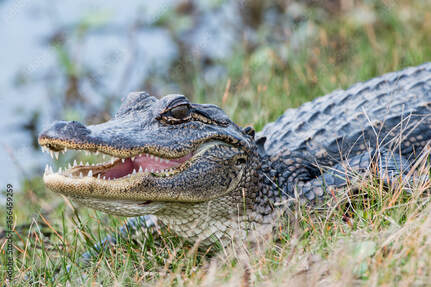Current Conservation Status For American Alligator:
Least Concern
SIZEHeight: 8-19 ft
Weight: 600-2,200 Pounds DIETHatchlings eat small fish and invertebrates. Adult alligators prey on larger animals such as birds and deer.
|
LIFESPANWild Lifespan: 30-50 years
Captive Lifespan: 60-80 Years HABITAT & RANGEFreshwater swamps, rivers, and lakes in south eastern United States.
|
The American Alligator is one of the most successful conservation stories to date - a natural resource that is cultivated mainly for it's leather.
"Each and every skin tanned by American Tanning & Leather LLC is harvested legally and in accordance with all state, federal, and international wildlife regulations. We never buy, sell, or promote any endangered species of crocodile or alligator, and it is our promise to exclusively provide clients with luxury leathers that are from sustainable and ethically sourced raw materials.
The CITES tag on each skin guarantees that your product is part of a sustainable use program which benefits both people and wildlife. The use of alligator and crocodile products protects the traditions and cultures of a community dependent upon renewable natural resources for economic sustainability."
amtan.com/responsibility.html
American Tanning & Leather provides a wealth of knowledge paired with generations of experience working with and conserving the American Alligator.
The CITES tag on each skin guarantees that your product is part of a sustainable use program which benefits both people and wildlife. The use of alligator and crocodile products protects the traditions and cultures of a community dependent upon renewable natural resources for economic sustainability."
amtan.com/responsibility.html
American Tanning & Leather provides a wealth of knowledge paired with generations of experience working with and conserving the American Alligator.
How has conservation impacted American Alligators?
Brass Tacks:
- In 1967, the American alligator was placed on the endangered species list as the result of over hunting and habitat loss. After conservation efforts, their population was declared recovered in 1987.
- Unlike many reptiles, alligators provide parental care to their young. The mother will fiercely protect her nest from intruders. Once the eggs hatch, she moves the hatchlings to a safe area and continues to protect them for a few months.
- The largest threat to the American Alligator is habitat loss. This species is an incredibly clear example of the phrase: "If it pays it stays" - indicating that communities can be motivated to protect and conserve nuisance native species if the species in question can bring a financial benefit to the local economy.
Want information on a specific species without waiting?
Conservation and ethical use is an incredibly important subject that deserves time and attention.
This informational section of our website is under constant construction and no information will be uploaded without intensive research into the topic/species first.
We understand you may want information on a certain species. Please keep in mind each species we utilize WILL be added to this page and we appreciate your patience while we gather accurate information for you.
*Source information will be listed when applicable
This informational section of our website is under constant construction and no information will be uploaded without intensive research into the topic/species first.
We understand you may want information on a certain species. Please keep in mind each species we utilize WILL be added to this page and we appreciate your patience while we gather accurate information for you.
*Source information will be listed when applicable
teton leather LLC
|
|
Copyright © 2015


